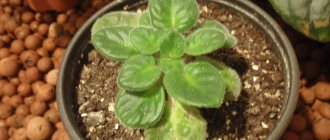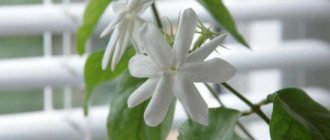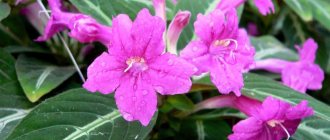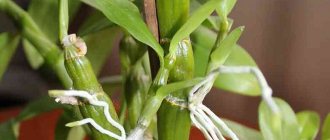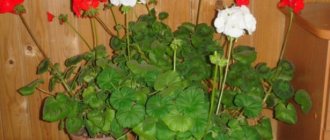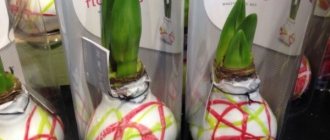Stephanotis still stands apart in the world of ornamental plants, and few gardeners decide to purchase this plant for propagation and care at home, in a greenhouse or in a garden.
But in vain. This semi-shrub vine is a real miracle of nature. And it’s not just about appearance, although appearance is her main trump card.
Long stems, attached to a support, shoot upward and release numerous opposite-growing leaves: elastic, slightly pointed, with a beautiful glossy shine. And from the beauty of the flowers, blooming in abundance here and there, the heart swells with delight.
Popular varieties and their photos
There are few species - only 16. Below are the names, descriptions and photos of the main varieties of stephanotis (floribunda, variegated, variegated), for propagation and care at home.
The name is translated as “pig ears,” probably due to its external resemblance to hoyas. However, among the people, stephanotis was awarded a more elegant name - “Madagascar jasmine”. The homeland of the exotic is Madagascar, the Malay Archipelago, Japan, China. Belongs to the Lastovniev family and was first described in 1806.
Floribunda
The most popular for propagation and care at home is Stephanotis floribunda (Stephanotis Floribunda). Outwardly it looks like a climbing shrub; in the wild it grows up to 5 meters in height. The leaf blades grow opposite each other, they are oval, pointed, entire, dark green in color and with a beautiful shine. The flowers are large, pure white, collected in false umbels (5 cm wide and 4 cm long) and smell very pleasant. It grows well both in homes and in greenhouses and winter gardens.
Photo of flowering variety Floribunda
Variegated
Stephanotis variegata is also suitable for home cultivation, but it is very different from the above-mentioned species - it is not so beautiful in appearance. Its large leaves are covered with white and yellowish spots along the edges, the stems are thick and strong.
Akuminata
Stephanotis acuminata is the most demanding of all varieties. Only a professional gardener with great patience can grow it, capable of creating all the necessary conditions for this capricious exotic. The flowers of akuminata are not white, but cream, more elongated and small.
Photo of flowering variety akuminata
Types of stephanotis with photos
There are 15 species of stephanotis in nature. Only one species is fully cultivated - Stephanotis profusely flowering.
Stephanotis floribunda, or wax flower
The shoots of such an evergreen vine can be about 500 cm long or even more. The shiny, dense green leaf plates can reach the size of a human palm. During abundant flowering, fragrant tubular flowers of cream or white color appear on the bush. The corolla reaches a diameter of about 50 mm, and it contains five petals. The flowers are collected in loose bunches. About 7 buds can form on one stem.
Stephanotis floribunda variegate
This is a variation of the previous type. The tops of the green leaf blades seem to be smoothed out. The green leaves are decorated with yellow, pale green and white stripes and spots.
Care
Priming
The soil is suitable for universal and special purposes for semi-shrub vines. Both of them can be bought at any flower shop. But it’s easy to make the mixture yourself.
Get and mix the necessary ingredients : humus (1 part), sand (1 part), deciduous soil (3 parts) and clay-turf soil (2 parts). Instead of humus, you can use finely ground pine bark. It wouldn't hurt to add a handful of bone meal. Be sure to treat the prepared mixture against pests. This can be done in several ways.
Freezing
Wrap the soil in a cloth bag and put it in the freezer for a week, then take it out into the heat for a week and repeat the freezing procedure. This will help destroy pest eggs, but will not save you from late blight.
High temperature action
Use the oven: spread a thin layer of soil on a baking sheet and bake for half an hour at a temperature of 90 degrees. The second option is more gentle - steaming over a bucket of water. Wrap the soil in a cloth bag, place it on a grate, and place the grate on a bucket of water on the stove. Steaming time is at least 90 minutes. These two methods work well against pests, but deteriorate the quality of the soil, so immediately after treatment, apply bacterial fertilizer.
Treatment with chemicals
You can use the usual potassium permanganate (for 10 liters of water - 3-5 g of crystals at the rate of 30-50 ml per square meter of soil), but fungicides "Barrier", "Planriz", "Extrasol", "Glyokladin" and insecticides have proven themselves
“Aktara”, “Iskra”, “Thunder”, “Inta-vir”. Before use, carefully read the instructions and strictly follow the dosages.
Don't forget about drainage: pebbles, broken bricks, expanded clay. Treat it in the same way as soil. The drainage percentage is 20% of the height of the pot.
Permissible acidity – 5.5-6.5 pH
What kind of pot does a flower need?
When choosing a pot, it is better to choose a ceramic container. With good care, Stefanotis grows quickly and is capable of overturning a container made of lighter material (plastic, for example). Before planting, be sure to soak in water for 2-3 hours (to remove harmful substances and gases), wash thoroughly with soap and water and pour over boiling water. If you are using an old pot in which something has already grown before, after washing, douse it with hot water and baking soda.
Lighting
Stephanotis loves light, but does not like direct sun - its rays burn the leaves. And, strange as it may sound, excess light causes the plant to slow down its development rate. Therefore, choose window sills for planting - a western or eastern window will do. The southern one is also possible, but prepare a screen or thick curtains for shading.
On cloudy autumn days and throughout the winter, it is necessary to use backlighting. Install 30-watt fluorescent light bulbs on the sides of the plant (at a distance no closer than 20 and no further than 25 cm).
Temperature
The standard temperature regime of a modern apartment or private house is quite satisfactory for the Madagascan exotic. Maintain readings from +14 to +25 degrees .
In summer they are increased, and in winter they are decreased. It is this wintering that helps stephanotis bloom for a long time. On warm spring and summer days, take the pot out into the garden or onto an open balcony to soak up the fresh air. However, beware of drafts and strong winds - the plant does not like them. This also applies to sudden temperature changes.
How to water?
Stephanotis loves water, but watering must be organized wisely. Make sure the soil in the pot is dry before watering it properly. Usually this needs to be done once every three to four days.
Be careful during the period when the heating is turned off, when the temperature fluctuations in the room and outside are constant, and the humidity also changes. Do not let the soil get wet from your excessive generosity! It is easier for Stephatonis to survive slight drying out of the soil than flooding.
Water for irrigation should be at room temperature and soft . Do not use tap liquid - it contains too much bleach and salts. Leave the water to stand for a day before watering, pouring it into a container without a lid.
Maintain air humidity at a certain level, it is especially important to do this during the heating season. Heat from radiators does not benefit stephanotis, so pamper your pet with a warm shower several times a week (wrap the pot in plastic so as not to flood the soil), place a household humidifier nearby, place a saucer of water on the windowsill, or cover the radiator with a damp towel.
Top dressing
Stephanotis needs to be fed in spring and summer, once every two weeks. In March-April, the amount of fertilizer increases: dissolved cow manure or phosphate. From September to March there is no need to apply fertilizer.
Transfer
Stephanotis should be replanted after purchase immediately after the quarantine period, since store-bought soil is not suitable for further cultivation.
Since the best time for stephanotis to take root is spring, wait to purchase a flower until then. Replanting should be done using the transshipment method : keeping the earthen ball, watering 2-3 days after the procedure.
Other transplants are carried out as needed, but preferably no more than once every 2 years. Be sure to install a strong support so that the vine can gain a foothold on it and develop to its full potential.
Trimming
Stephanotis should be pruned every spring because flowers appear only on young shoots. The procedure is carried out immediately after transplantation, using a disinfected stationery blade. You can't use scissors - they will ruin the stems!
in winter
Winter for Madagascar jasmine is a period of rest and strengthening of the immune system . Water it carefully, protect it from the dry air of batteries and do not disturb it with fertilizing.
Maintenance errors, diseases and pests - table
Due to improper care, Stefanotis loses its attractiveness and stops blooming.
| Error | Manifestation | How to eliminate, prevention |
| — Drafts, sharp drop in temperature. | Leaves are falling. | Place the flower away from drafts at the optimal temperature. |
| - Little light. — Hard irrigation water. — High air temperature. | The leaves turn yellow and fall off. | - Put the flower in the light. - Water with water that has stood for at least 24 hours. — If it’s hot, increase the humidity. |
| — Too much nitrogen. — Not enough light. — The plant is resting. | Doesn't bloom. | - Do not overfeed with nitrogen. - Use phytolamps. — During the dormant period, place in a cool place. |
| Lack of nutrition. | Growth has slowed or stopped. | Fertilize the flower, especially during the growing season. |
| - Drafts. - Lack of watering. - Change of place. | The buds are falling. | — Avoid drafts, dry out soil, maintain moderate humidity. — Do not twist or transfer during the flowering period. |
Improper care weakens the flower, making it more susceptible to diseases and pests.
| Pests and diseases | Manifestation | Treatment | Prevention |
| The root and base of the stem rots. | The roots and stem darken and decompose. | The disease can be cured at an early stage by transplanting the flower into a completely replaced substrate, removing rotten roots, and treating it with Fundazol. | — Compliance with watering regimes. — Soil disinfection. — Preventing drafts and temperature changes. |
| Powdery mildew | At an early stage there is a white powdery coating on the leaves. Gradually, the leaves become covered with spots on all sides, interfering with normal photosynthesis. As a result, they dry out. Then the flower dies. | Pick off the affected leaves. Treat the plant with a special preparation, for example, Fundazol. During the treatment period, do not spray the leaves. For prevention or at the onset of the disease, you can treat with a solution of potassium permanganate - 2.5 g per 10 liters of water. Just 3 sprays once every few days. | — Observe the watering regime. — Place the flower in a sunny place. |
| Fungus gnat | The danger comes from insect larvae that feed on young flower roots. | You can fight it by spraying Raptor near the flower. Fly eater is used against mosquito larvae. In order for the drug to work, you should not water the soil for 5 days. | — Avoid soil acidification, follow the rules and watering schedule. — Catch insects with sticky traps or repel them with the smell of citrus fruits. |
| Aphid | Sugary coating on the leaves, then they become deformed and die. | Special preparations are used against these insects: Aktara, Actellik, Decis. Treat the flower with the drug, repeat after 7 days. It is recommended to use different means alternately. In case of severe damage, repeat the procedure 3 times. At the first sign, it is enough to wash the leaves with warm water. Treatment with a soap solution gives excellent results. | Maintain an optimal level of humidity in the air where the flower grows, since aphids are present in waterlogged air. |
| Shchitovka | It feeds on the juice of the flower. As a result, the leaves turn yellow and fall off, and the flower itself dies. | Treat the plant with preparations, for example, Fitoverm, several times. Treatment is carried out once a week until the pest is completely eliminated. A plant affected by scale insects must be immediately placed separately from the rest. Wipe the leaves with a solution of laundry soap or a weak solution of vinegar essence. | After getting rid of the insect, check the plant from time to time for its presence, because it may appear again. |
Reproduction
Cuttings
The best option for propagating stephanotis is by cuttings.
- Cut off young upper shoots from the plant several internodes long.
- Treat the cut areas with crushed activated carbon, root or epin, and plant in the prepared container. The soil for the container is a mixture of sand and peat.
- Organize a greenhouse: cover the container with plastic film or glass, and place it in a warm place, bright, but protected from direct sunlight. The temperature for growing is not lower than +27 degrees, arrange bottom heating if necessary. Ventilate the greenhouse every day, loosen the soil little by little and water it carefully.
- When the first roots appear, transplant the cuttings into separate pots.
Instead of soil, you can use water for propagation. The shoots are placed in cups with fresh water (the cuttings should have 2-3 node buds), a greenhouse is set up and germinated on the windowsill. With the appearance of the first roots, stephanotis is transplanted into light soil until new leaves appear, and then to a permanent place of residence.
Seeds
It is possible to grow stephanotis from seeds, but this process is so labor-intensive and time-consuming that only professionals do it. The seeds of the plant are formed in oval boxes , from which they fly out as soon as it dries and cracks. However, this almost always happens only under natural conditions.
- Buy seeds only from a trusted store. Be sure to check the expiration date, check the integrity of the packaging and the quality of the seed material. Pour the seeds into a glass of salted water and stir with a spoon: the empty seeds will rise to the top. Collect them and throw them away.
- Seeds, like cuttings, are planted in a greenhouse, in soil made of peat and sand. Sow not too thickly and without digging into the soil (it is enough to press 1 cm). The first shoots should appear in two weeks, and after another 10-14 days the sprouts will be ready for transplanting into separate pots.
Transfer
Since stephanotis is a large flower and not very mobile due to its attachment to a support, replanting can cause certain difficulties. The good news is that it does not need frequent replanting and can grow for a long time in a cramped pot, disproportionate in size to the crown. Moreover, not critical crowding stimulates flowering. However, a newly purchased specimen must be replanted without fail, since most often the plant is sold in a temporary transit substrate.
Due to the dense root system, replanting is carried out using the transshipment method, filling the resulting voids with new soil. With normal development of shoots, their annual growth is about one and a half meters.
It is not recommended to buy specimens with vines longer than 1.5-2 m.
Substrate
The soil can be made from garden soil with the addition of the same amount of compost, high peat and coarse sand. Other possible components: leaf and turf soil or leaf humus.
Of the ready-made compositions, universal substrates are suitable for indoor flowering crops, but a self-made soil for this plant is preferable; it should be quite dense and heavy.
It is worth paying attention to the drainage hole in the pot; it is better if there is more than one and not small. Drainage is placed at a height of about 20% of the entire pot.
It would be very prudent to immediately take care of the support and its reliable fastening, taking into account growth.
If you add a small amount of root formation biostimulator to the water during the first watering after transplantation, the adaptation process will be easier and faster.
Pests
All house plants suffer from spider mites and stephanotis is no exception . This little bug is extremely fertile and tenacious, sucking sap from the plant at a sprinting speed and adapting to poisons. Destroying it is not easy. It lays eggs not only on leaves and the ground, but also in the cracks of window sills and frames, and on greenhouse trellises.
Signs of damage are the appearance of white, gradually darkening spots on the leaves, cobwebs entangling the trunk and cuttings, wilting of greenery and buds, poor growth.
Appears in dry air as a result of improper care (at humidity above 80% the tick dies).
First, rinse the flower in the shower, covering the soil with film. This will help get rid of the adults. After: remove withered leaves and stems, and use any folk remedy (provided that the plant is not badly damaged): turpentine, garlic and onion pulp, a solution of green or tar soap, infusion of dandelion or calendula.
If there are a lot of pests, chemicals (Apollo, Nissoran, Oberon, Flumite, Sunmite, Floromite, Kleschevit) or biological products (Aktofit, Vertimek, Akarin) can help ", "Fitoverm"). Number of treatments – at least 3 with an interval of 3-6 days.
Aphids are an equally dangerous enemy for stephanotis. It prefers young plants because it is not able to pierce a hard leaf plate with its proboscis.
Brown spots appear on the leaves, the plates become deformed, become covered with honeydew, and gradually with sooty fungus.
Among the folk remedies, a soap solution (4-5 tablespoons of soap shavings per liter of warm water), an infusion of ash (a handful per 5 liters), and tobacco infusion (infuse a glass of shag in 5 liters of boiling water for 24 hours) help well. Chemicals: Karbofos, Aktara, Intavir. Remember: young plants may die from treatment with chemicals, so in case of mass damage, propagate by cuttings.
Possible growing problems
The most common diseases encountered are powdery mildew and root rot. Both are usually the result of over-hydration when kept cold. Fungal infections, if the percentage of damage has not reached critical values, the disease is treated with fungicides, which requires a complete revision of the root system with the removal of affected areas and correction of growing conditions.
Other possible problems:
- The leaves are turning yellow. Stephanotis turns yellow due to lack of lighting or insufficient humidity. Watering with too cold and hard water can also provoke a problem.
- The buds are falling. There may be several reasons - a draft, insufficient watering, or rearranging the pot relative to the light source. During budding, it should stand in one place and the same side to the light source.
- There is no flowering. A very common situation associated with insufficiently comfortable living conditions. It is necessary to review all plant care in accordance with the recommendations.
- Flowers wither prematurely. Most likely, they lack moisture and light. With proper agricultural technology, flowering should last for several months.
Diseases
- If the buds of stephanotis wither and fall off, you either did not protect it from a draft or did not add water when watering.
- What to do if the leaves turn yellow? Yellowing of leaves has several causes. The problem may be a lack of light, too hard water or low temperature. Lack of drainage in the pot, stagnation of moisture, and lack of nutrients also have a negative effect.
- Why does stephanotis not bloom and what to do in this case? The plant does not want to bloom for the following reasons: the flower does not receive enough nutrition or light. And don’t forget to provide the vine with a comfortable winter!
If you notice that stephanotis has decided to produce buds, do not move it to another place. During the budding period, the plant is especially vulnerable and will refuse to bloom if disturbed.
Stephanotis flowers smell wonderful, but prolonged inhalation of the aroma can cause headaches , dizziness and nausea, so it is better to take the flowering plant out of the bedroom at night.
Flower and fruit
The flowering period for indoor stephanotis is summer or early autumn. Flowers in inflorescences of approximately 10 pieces. Madagascar jasmine is a monoecious plant. Artificial pollination should be done with a thin artistic brush, transferring pollen from the stamens of some flowers to the pistils of others.
Important: There is no need to place a flowering vine in the bedroom or children's room, since prolonged inhalation of its aroma can cause migraines and discomfort.
Stephanotis fruits take 9 months to ripen. The berries can reach 10 cm, are green at first, then turn yellow and wrinkle. After the seeds ripen, the fruit bursts and the seeds scatter from it. Each fruit has an average of 100 seeds. Each seed has a fluffy parachute, with the help of which it can fly with the wind over a long distance. To preserve the seeds before ripening, you need to put a nylon bag on the fruit.
Can I keep it at home?
Stephanotis, according to legend, negatively affects male energy, weakens it and makes a man lazy and lethargic. Therefore, you should not place the plant in his office, for example, or on his side of the bed. Otherwise, there are no prohibitions or restrictions.
The juice is very caustic and, if it gets into the eyes or on the skin, can cause severe irritation and often a burn.
Therefore, when replanting, propagating or simply inspecting the plant, prepare thick gloves and make sure that the juice does not splash into your eyes. For the same reason, keep small children and pets away from stephanotis.
Stephanotis care video
Stephanotis is an unpretentious plant, but very delicate.
The only thing you should remember when choosing a flower for your home collection is that it does not like drafts and sudden temperature changes. In winter, it is better to choose conditions for it that are close to those of a greenhouse, and in summer, shade it from the sun’s rays and spray it regularly. If you place the plant in the loggia, you will soon feel an amazing floral aroma. You can also share your secrets for caring for stephanotis. If you have questions, ask them in the comments below, we will be happy to answer them.
Signs and superstitions
Stephanotis is considered not only beautiful, but also a truly feminine flower. It is believed that the plant prolongs youth and does not allow beauty to wither, giving charm and femininity to its owner. In Madagascar, there has long been a custom of giving an unmarried girl stephanotis , which, according to legend, will lure female happiness and a good groom to the house with its flowering. And at least one flower must be inserted into the wedding bouquet, then the feelings between the spouses will not cool down, and the marriage will be happy and long.
Features of growing stephanotis at home
Microclimate and lighting
Stephanotis is a fast-growing and unpretentious plant, but does not like temperature changes. In winter, it is kept in cold greenhouses with a temperature of 12-16 ° C and bright lighting, but without drafts. In summer, shade from direct sunlight by spraying leathery leaves in hot weather. In a dry room with high temperatures in winter, stephanotis can be damaged by spider mites.
If stephanotis leaves turn yellow and begin to fall off, the cause may be a lack of lighting or problems with the root system; you may need to transplant it into a larger pot with fresh soil. In summer, Stephanotis is taken out onto glassed loggias, which the plant fills with beautiful flowers and aroma.
Watering
Stephanotis loves regular and abundant watering with soft water. In winter, after flowering, water it moderately, not allowing the earthen ball in the pot to dry out, it is important that the soil in the pot is constantly moist, but puddles should not be created, it is necessary to spray the air around the plant more often.
Soil and fertilizer
Stephanotis is planted and replanted in a heavy soil mixture. To prepare the soil, use deciduous, clay-turf soil, peat (or humus) and sand in a ratio of 3:2:1:1. The dishes should be large and capacious - stephanotis has a powerful root system, and drainage is provided at the bottom. This plant prefers soil with a slightly acidic reaction; an alkaline environment can lead to a lack of flowering in stephanotis. In the spring, during transplantation, the stephanotis stems can be cut in half. Flowering usually begins in June and lasts until September. And in order to prolong the abundant flowering, in the middle of summer its shoots are pinched, leaving up to 8 pairs of leaves on the stem.
Stephanotis does not require frequent fertilizing, and prefers potassium fertilizers rather than nitrogen ones. From nitrogen it grows stems and leaves, does not bloom and overwinters poorly, not having time to stop growth; subsequently, such stephanotis lashes have to be completely cut off, slowing down the moment of flowering even next year. Flowering is stimulated by mineral flower fertilizers with microelements, or solutions of potassium salt and superphosphate, which are applied 1-2 times before flowering begins in May. You can water it with mullein solution.
Photo gallery
sultanova_sad
tsvetochnyj_raj_kirov
soloma31rus
marianisenbaum
flora_florastrakhan
sashalupu
Possible difficulties
- When the buds form, the plant reacts very poorly to changes in location, so a light mark must be applied to the pot.
- Lack of water, temperature fluctuations, and drafts can cause buds to fall off.
- In low light and temperature changes, even with regular feeding, flowers may not appear.
- With insufficient watering, unopened buds may wilt.
- When watering with hard water and lack of light, the leaves may turn yellow.
Beliefs about Stephanotis
There are many superstitions associated with the Madagascar vine.
For some reason, most Asian peoples do not recommend growing this flower to single women. It is believed that Stefanotis drives men away from the threshold of the house. And also, married couples should not keep it at home, because this is fraught with divorce. But in North and Central America there is a sign that if Stefanius blooms prematurely in the house where a girl lives, she will certainly get married in the coming year.
In Western countries, Stefanotis flowers are often used to form wedding bouquets in the belief that their bright aroma during the celebration will attract even greater luck and happiness for the newlyweds and their marriage will last until death.
Only one thing is true, Madagascar jasmine is truly an amazing plant with magnificent flowers that will fill any home or office with a pleasant spring aroma.
Description of the plant
Stephanotis is a Greek name meaning “crown of ears” or “crown of ears.” Because “stephanos” is translated from Greek as “crown”, and “otos” means “ear”.
Stephanotis is a vine of the Lastovnevy family. Grows in Madagascar, China, Japan and Malaysia. Only 15 species of this plant have been found in nature.
Madagascar jasmine is a perennial with evergreen leaves and fragrant, milky flowers.
Wild stephanotis grows very quickly and can reach a length of up to six meters. Ornamental species are limited to a meter in length; they are used as hanging plants or placed on supports.
The leaves have an emerald, glossy color and an oval shape. The flowers are milky white, tubular in shape, collected in umbels. The plant is grown and valued precisely for its beautiful flowers and very pleasant smell during flowering.
Species diversity and variety for home
There are only 16 species (according to some sources only 12) of stephanotis. The table will help you find out the characteristics of the most popular varieties.
Table - Varieties of stephanotis and their features
| Variety | Peculiarities |
| Floribunda/full blooming | Snow-white star flowers 5-6 cm in diameter |
| Floribunda variegata | On the leaf plate there are spots and stripes of yellow, light green, white shades |
| Thorsia | Soft purple inflorescences |
| Akuminata | Cream flowers |
| Grandiflora | Large inflorescences: one contains up to 30 flowers |
The only variety suitable for indoor growing is Stephanotis profusely flowering. Although the liana needs special conditions, it can easily adapt to the windowsill. Ideally, if it is possible to grow Madagascar jasmine in a winter garden or greenhouse.
Beautiful star flowers of a profusely blooming variety are often used to create a bridal bouquet: the composition with delicate inflorescences looks stylish and touching. By the way, there was also a place for “stars” in Princess Diana’s bouquet that went down in history: a luxurious cascade of white fragrant flowers almost touched the ground.
